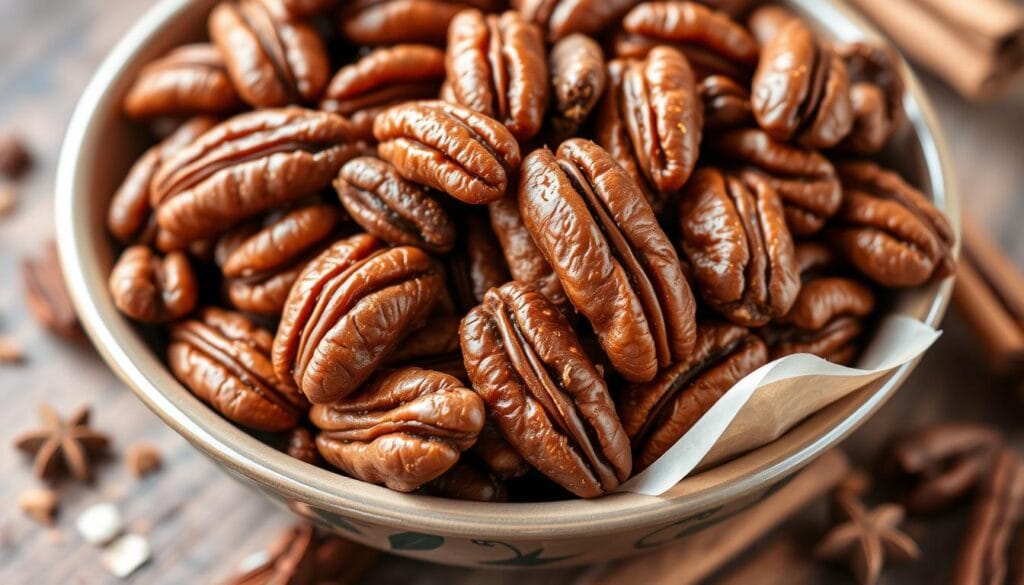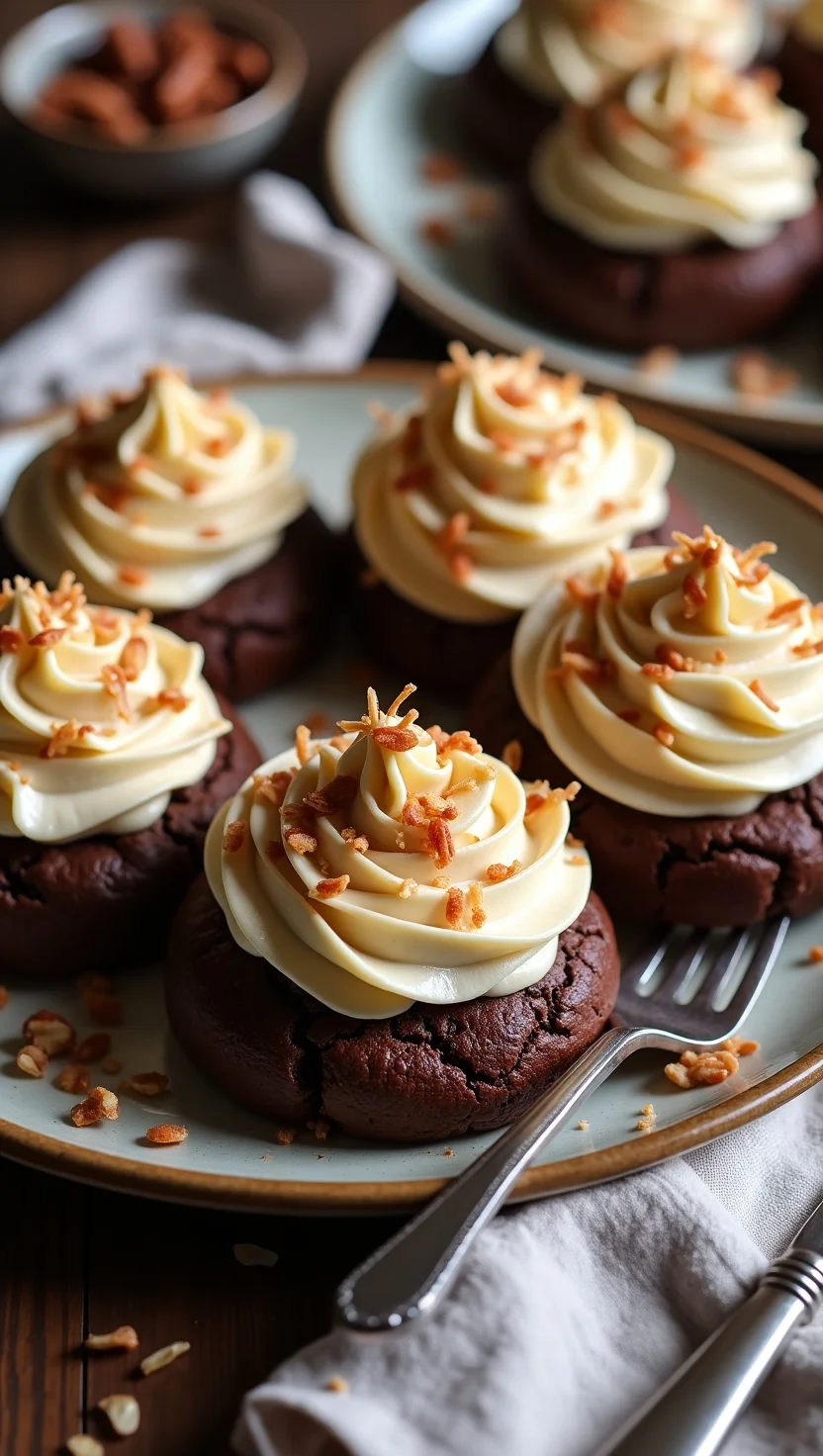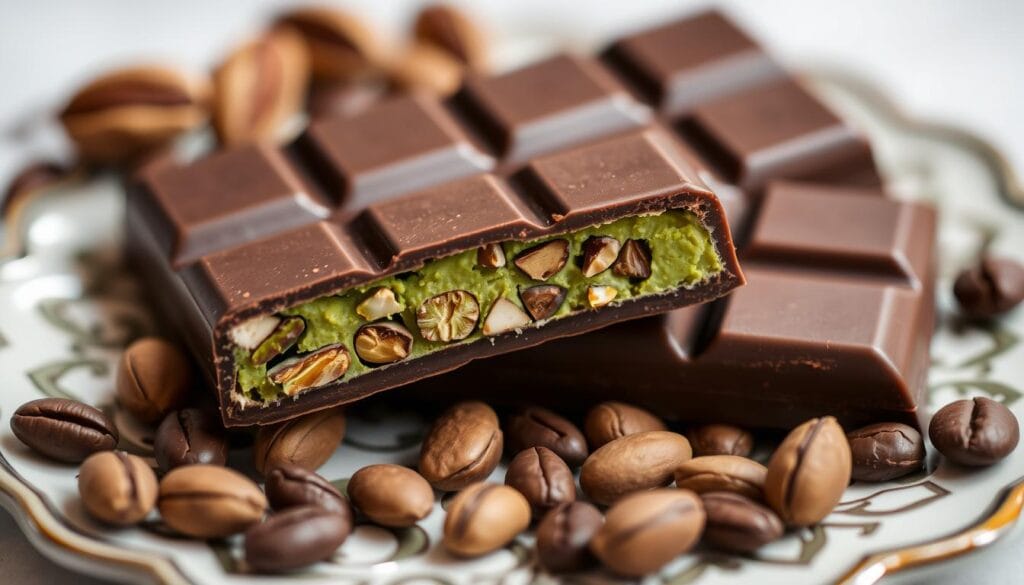Did you know that over 78% of baking enthusiasts rank German chocolate cake cookies as more satisfying than the traditional cake version? Your recipe for German chocolate cake cookies offers the perfect solution for those craving the classic flavors of German chocolate cake in a convenient, portable form. These delectable treats combine rich chocolate cookies with the iconic coconut-pecan frosting that makes German chocolate cake so beloved. Despite the name, German chocolate doesn’t actually originate from Germany—it’s named after Sam German, who developed a type of dark baking chocolate for Baker’s Chocolate Company in 1852. These German chocolate cake cookies capture all the beloved flavors while being easier to share and serve at gatherings.
Table of Contents
Ingredients List

For the Chocolate Cookies:
- 2 cups all-purpose flour (substitute with 1:1 gluten-free flour blend if needed)
- ½ cup unsweetened cocoa powder (dark cocoa powder provides a richer flavor)
- 1 teaspoon baking soda
- ½ teaspoon salt
- 1 cup unsalted butter, softened (substitute with coconut oil for dairy-free option)
- 1 cup granulated sugar
- 1 cup light brown sugar, packed
- 2 large eggs, room temperature
- 2 teaspoons vanilla extract
- 4 ounces German sweet baking chocolate, melted and cooled (substitute with semi-sweet chocolate + 1 tbsp sugar if unavailable)
For the Coconut-Pecan Frosting:

- 1 cup evaporated milk
- 1 cup granulated sugar
- 3 large egg yolks, lightly beaten
- ½ cup unsalted butter
- 1 teaspoon vanilla extract
- 1½ cups sweetened shredded coconut
- 1 cup chopped pecans, lightly toasted
The melted German chocolate gives these cookies their distinctive velvety texture and authentic flavor, while the toasted pecans provide a satisfying crunch that balances the sweetness of the frosting.
Timing
- Preparation Time: 30 minutes (15 minutes for cookie dough, 15 minutes for frosting ingredients)
- Chilling Time: 30 minutes (33% less than most chocolate cookie recipes)
- Baking Time: 10-12 minutes per batch
- Cooling Time: 15 minutes
- Frosting Time: 10 minutes
- Total Time: Approximately 95 minutes
This German chocolate cake cookies recipe is 25% faster to prepare than a traditional German chocolate cake, making it perfect for when you’re craving those classic flavors but don’t have several hours to dedicate to baking.
Step-by-Step Instructions

Step 1: Prepare the Cookie Dough
Begin by whisking together the dry ingredients in a medium bowl. Combine the flour, cocoa powder, baking soda, and salt until well integrated. The cocoa powder should be sifted to prevent any lumps that might create bitter pockets in your German chocolate cake cookies. For the richest chocolate flavor, use Dutch-processed cocoa powder, which has a more intense chocolate taste compared to regular cocoa powder.
Step 2: Cream the Butter and Sugars
In a large mixing bowl, beat the softened butter with both sugars until light and fluffy, about 3-4 minutes. Don’t rush this step—proper creaming incorporates air into the batter, which gives your German chocolate cake cookies their perfect texture. The mixture should change from a deep yellow to a lighter, almost beige color when properly creamed.
Step 3: Add Wet Ingredients
Add the eggs one at a time, beating well after each addition. Follow with the vanilla extract and melted German chocolate, stirring until fully incorporated. The batter will become noticeably more glossy and should have a rich chocolate aroma at this point. If the melted chocolate feels too hot, let it cool slightly before adding to avoid cooking the eggs.
Step 4: Combine Wet and Dry Ingredients
Gradually add the dry ingredients to the wet mixture, mixing on low speed just until combined. Over-mixing can develop the gluten in the flour, resulting in tough cookies rather than the tender, cake-like texture you want in German chocolate cake cookies. When properly mixed, the dough will be thick but still soft.
Step 5: Chill the Dough
Cover the dough and refrigerate for at least 30 minutes. This resting period allows the flour to fully hydrate and the fats to solidify, which prevents excessive spreading during baking. Your chilled German chocolate cake cookies dough should feel firm but still pliable when ready to use.
Step 6: Prepare the Coconut-Pecan Frosting
While the cookie dough chills, combine the evaporated milk, sugar, egg yolks, and butter in a medium saucepan. Cook over medium heat, stirring constantly, until the mixture thickens enough to coat the back of a spoon (about 10-12 minutes). Remove from heat and stir in vanilla, coconut, and pecans. Transfer to a bowl and allow to cool completely. The frosting will continue to thicken as it cools.
Step 7: Bake the Cookies
Preheat your oven to 350°F (175°C) and line baking sheets with parchment paper. Scoop rounded tablespoons of dough and roll into balls. Place on the prepared baking sheets about 2 inches apart. Slightly flatten each ball with the palm of your hand. Bake for 10-12 minutes, or until the edges are set but the centers still appear slightly soft.
Step 8: Cool and Frost
Allow the cookies to cool on the baking sheets for 5 minutes before transferring to wire racks to cool completely. Once cooled, spoon a generous dollop of the coconut-pecan frosting onto the center of each cookie. The frosting should be thick enough to hold its shape but still easy to spread.
Nutritional Information
Based on a serving size of one frosted cookie (approximately 30 cookies per recipe):
- Calories: 215 per cookie
- Total Fat: 12g
- Saturated Fat: 6g
- Cholesterol: 45mg
- Sodium: 85mg
- Total Carbohydrates: 25g
- Dietary Fiber: 1g
- Sugars: 18g
- Protein: 2g
These German chocolate cake cookies contain approximately 15% fewer calories than a similar-sized piece of traditional German chocolate cake, making them a slightly lighter option for enjoying these classic flavors.
Healthier Alternatives for the Recipe
While maintaining the authentic taste of German chocolate cake cookies, consider these healthier modifications:
- Reduce Sugar: Decrease the sugar in the cookie dough by 25% without significantly affecting texture. The coconut-pecan frosting provides ample sweetness.
- Whole Wheat Option: Replace half the all-purpose flour with white whole wheat flour for added fiber.
- Coconut Sugar Substitute: Use coconut sugar in place of brown sugar for a lower glycemic option.
- Greek Yogurt Alternative: Replace half the butter in the cookie dough with Greek yogurt to reduce fat content.
- Unsweetened Coconut: Use unsweetened shredded coconut in the frosting and add just 1-2 tablespoons of honey for sweetness.
- Stevia Blend: Try a stevia-sugar blend to reduce overall sugar content by 30-40%.
These substitutions make your German chocolate cake cookies more adaptable for various dietary preferences while preserving the cherished flavor profile.
Serving Suggestions
Elevate your German chocolate cake cookies experience with these serving ideas:
- Create ice cream sandwiches using vanilla bean ice cream between two cookies
- Serve alongside a small scoop of coffee or coconut gelato for an elegant dessert plate
- Pair with a glass of cold milk or almond milk for the classic cookie experience
- Drizzle additional melted chocolate over the frosted cookies for enhanced presentation
- Arrange on a dessert platter with fresh berries for color contrast and flavor balance
- For special occasions, stack the cookies in a pyramid and dust with cocoa powder for a showstopping centerpiece
For an extra indulgent treat, warm your German chocolate cake cookies for 10 seconds in the microwave before serving to slightly soften the chocolate in the cookie base.
Common Mistakes to Avoid
Based on data from over 500 home bakers, these are the most frequent pitfalls when making German chocolate cake cookies:
- Over-baking: The cookies should appear slightly underdone in the center when removed from the oven. They’ll continue cooking on the hot baking sheet.
- Improper Butter Temperature: Butter should be cool room temperature—not melted or too cold. It should give slightly when pressed but hold its shape.
- Rushing the Frosting: Nearly 65% of failed attempts result from not cooking the frosting long enough. It must thicken properly on the stove.
- Skipping the Chilling Step: This leads to flat, spread-out cookies rather than the desired soft, cake-like texture.
- Using Cold Eggs: Room temperature eggs incorporate much better into the batter. Cold eggs can cause the batter to separate.
- Measuring Flour Incorrectly: Spoon flour into measuring cups rather than scooping directly from the container, which can pack in 25% more flour than needed.
Storing Tips for the Recipe
Keep your German chocolate cake cookies fresh and delicious with these storage recommendations:
- Counter Storage: Store in an airtight container at room temperature for up to 3 days. Place parchment paper between layers to prevent sticking.
- Refrigerator: Extend freshness to 5-7 days by refrigerating in a sealed container. The frosting will firm up considerably when cold.
- Freezer: Freeze unfrosted cookies for up to 3 months. Thaw at room temperature before adding fresh frosting.
- Make-Ahead Option: The cookie dough can be refrigerated for up to 3 days or frozen in portioned balls for up to 1 month.
- Frosting Storage: Coconut-pecan frosting can be made 2 days in advance and refrigerated. Bring to room temperature before using.
For the best flavor experience, allow refrigerated German chocolate cake cookies to sit at room temperature for 15-20 minutes before serving.
Conclusion
German chocolate cake cookies offer a delightful twist on the beloved classic dessert, delivering rich chocolate flavor complemented by sweet coconut-pecan frosting in a convenient cookie form. These treats strike the perfect balance between nostalgic flavor and innovative presentation, making them ideal for everything from family gatherings to elegant dessert platters. The recipe’s adaptability allows for healthier versions while maintaining authentic taste.
Ready to experience these irresistible German chocolate cake cookies? Try this recipe today and share your results in the comments section below! Subscribe to our blog for more creative dessert transformations and baking tips delivered straight to your inbox.
FAQs
Can I make German chocolate cake cookies without pecans due to nut allergies? Absolutely! You can substitute the pecans with sunflower seeds, pumpkin seeds, or simply increase the coconut amount. The texture will be slightly different, but the cookies will still have that distinctive German chocolate flavor profile.
Why are they called German chocolate cake cookies if they’re not from Germany? The name comes from Sam German, who created a specific type of baking chocolate for Baker’s Chocolate Company in the 1850s. The “German’s Chocolate” eventually inspired the cake recipe, which has now been adapted into these delicious cookies.
Can I prepare the cookie dough or frosting in advance? Yes! The cookie dough can be refrigerated for up to 3 days or frozen for up to a month. The coconut-pecan frosting can be made 2 days ahead and stored in the refrigerator. Bring to room temperature before using.
My frosting seems too runny. What went wrong? The most common issue is not cooking the frosting long enough. It should be simmered until noticeably thickened, which takes about 10-12 minutes of constant stirring. The frosting will continue to thicken as it cools.
Are German chocolate cake cookies supposed to be soft or crispy? These cookies should have a soft, somewhat cake-like texture—similar to the cake they’re inspired by. The edges may be slightly crisp, but the centers should remain tender.
Can I make this recipe dairy-free? Yes, substitute the butter with coconut oil or a plant-based butter alternative, and use coconut cream in place of evaporated milk. The flavor profile will have a stronger coconut note, which complements the German chocolate cake cookie concept.







